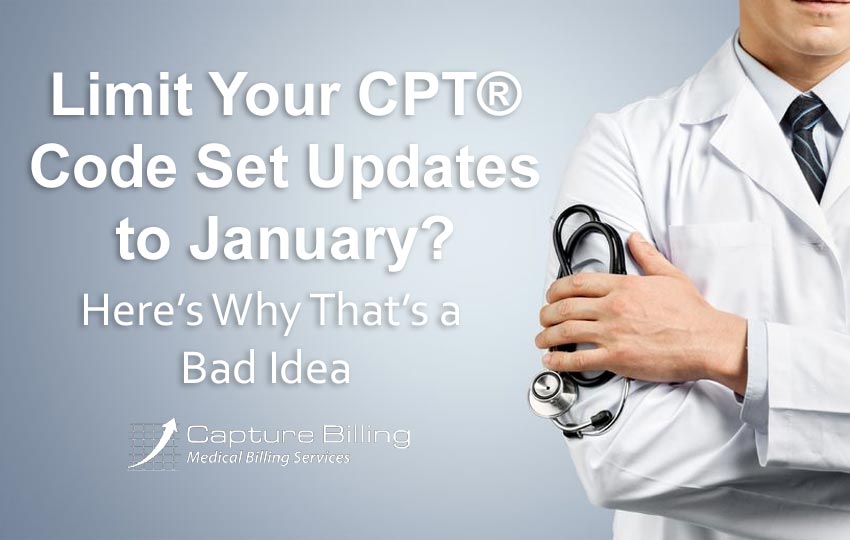
Guest Post from Deborah Marsh, JD, MA, CPC, CHONC, a senior content specialist for TCI SuperCoder.
Payers don’t accept deleted CPT® codes, so your claims can’t succeed if your medical procedure codes are out of date. But do you know how often you need to update your CPT® code set? It may be more often than you think. Here are some pointers to keep in mind to give your claims their best chance at accurate payment.
Make the Biggest Transition with January Updates
Each year, a new CPT® code set is effective on January 1. For instance, for CPT® codes, 2018 codes will give way to the 2019 code set on Jan. 1, 2019.
If you use an online CPT® code search product, you’ll want to be sure that the updates are searchable January 1. It’s also helpful if the CPT® lookup includes deleted codes (marked with the deletion date) because you use the code set based on the date of service. You may need access to previous code sets to finish filing claims and for working on appeals.
Plan for These Other Regular CPT® Code Set Releases, Too
The AMA, which owns and maintains the CPT® code set, implements certain types of codes more than once a year. You should be aware of these updates and have a strategy for ensuring you have them when you need them. All specialties may see CPT® updates throughout the year, but path/lab coders need to watch for a few special categories that apply to them.
Category III and vaccine codes: Category I vaccine codes and Category III codes (temporary codes for emerging technology and services) are implemented January 1 and July 1. You’ll typically find them posted on the AMA site six months before the codes are effective, giving you time to learn how to apply them.
Category II: Category II codes are tracking codes that you may use for performance measurement programs, like MIPS. The AMA site indicates you may see release March 15, July 15, and November 15, with implementation three months after release.
Molecular pathology tier 2 codes: To help with reporting MoPath procedures, these codes go from approved to effective fairly quickly. After approval by the CPT® Editorial Panel, codes are released to the AMA site March 1, September 1, and December 1. The effective date may be as soon as one month after the release.
Administrative MAAA codes: Similar to the MoPath codes, Multianalyte Assays with Algorithmic Analyses (MAAA) see a quickened schedule. After Panel approval, the codes are released to the AMA site March 1, September 1, and December 1. The effective date is typically one month after release, although some codes are held until the major January 1 update.
PLA: The schedule for proprietary laboratory analyses (PLA) code changes is quarterly, but publication and effective dates have varied as this new-ish type of code got off the ground. For 2018, the effective dates are January 1, April 1, July 1, and October 1.
Tip: This schedule of updates throughout the year is one reason why having an online CPT® code lookup resource is a good idea. Whether it’s in addition to your paper manual or an alternative to it, automatically updated CPT® codes online ensure you have the correct codes available to you.
And Don’t Forget Corrections May Happen Any Time
The AMA posts an Errata and Technical Corrections file on its site, and you need to be sure you check it regularly or make sure your online code-lookup provider incorporates any corrections. Often the AMA posts corrections before code set implementation as people report issues they find while preparing for the transition. But updates and corrections may occur at any point in the year, so don’t assume you can let down your guard early in the year.
Bottom line: Healthcare providers need access to up-to-date CPT® codes to ensure their claims are accurate for the date of service reported. Keeping codes current isn’t as simple as updating once a year in January. Make a plan to update your coding resource or keep an eye on your online coding solution to be sure it’s doing the update work for you.
 Deborah Marsh, JD, MA, CPC, CHONC, is a senior content specialist for TCI SuperCoder, working on everything from online tool enhancements and data updates to social media and blog posts. Deborah joined TCI in 2004 as a member of TCI’s respected Coding Alert editorial team.
Deborah Marsh, JD, MA, CPC, CHONC, is a senior content specialist for TCI SuperCoder, working on everything from online tool enhancements and data updates to social media and blog posts. Deborah joined TCI in 2004 as a member of TCI’s respected Coding Alert editorial team.
— This post Limit Your CPT® Code Set Updates to January? Here’s Why That’s a Bad Idea was written by Manny Oliverez and first appeared on CaptureBilling.com – Medical Billing Services. Capture Billing is a medical billing company helping medical practices get their insurance claims paid faster, easier and with less stress allowing doctors to focus on their patients.










 Deborah Marsh, JD, MA, CPC, CHONC, is a senior content specialist for TCI SuperCoder, working on everything from online tool enhancements and data updates to social media and blog posts. Deborah joined TCI in 2004 as a member of TCI’s respected Coding Alert editorial team.
Deborah Marsh, JD, MA, CPC, CHONC, is a senior content specialist for TCI SuperCoder, working on everything from online tool enhancements and data updates to social media and blog posts. Deborah joined TCI in 2004 as a member of TCI’s respected Coding Alert editorial team.